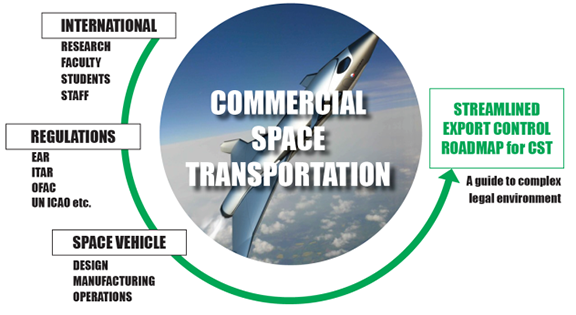402. Streamlined Export Control for Commercial Space Transportation
Team
| Name | Role | Primary |
|---|---|---|
| Ondrej Doule | Principal Investigator | ● |
| Henry Lampazzi | Tech Monitor | ● |
| Kelly Carnes | Fiscal Admin | ● |
| Manfang Xu | Fiscal Admin | ● |
Research Area
4.0 Space Transportation Industry Viability
Project Description
Commercial Space Transportation (CST) as an Industry seeks to fulfill both a domestic and international market space. The international leader in technology relevant to CST is the US, but the gap with international competition is lessening over time. This topic seeks to design a model, based on identified relative existing burdens, that more fully encompasses how US stakeholders in CST are effected by current US federal regulation; specifically “Export Control” laws (EAR, ITAR, OFAC) and relevant international laws (such as: UN ICAO), and how it affects communication between US commercial entities, regulators, and academia.

The US higher education environment, being highly international and focused sharing knowledge freely, clearly grapples with export control concerns to a great degree. Export control directly affects research performed by academics, commercialization efforts of newly developed technologies, development of spin-off technologies and technology transfer to industry. As such, developing an infrastructure model for optimized communication between academia and industry that complies with the current export control regime could directly serve to simplify the regulatory environment related to CST.
Project Outcomes
This proposal strives for a thorough analysis of the Export Control environment relevant to CST including Human Spaceflight to propose a normative framework for communication with the space industry to enable effective information exchange, enhanced workforce quality and faster innovation according to stakeholder need.
The three goals of this project intend to enhance the CST Economic environment by enabling faster access to the best technology and workforce available on the market. Further, understanding and optimizing communication between academia and the CST industry may directly translate to better collaboration with international CST organizations, as well as other public private partnership in the US. Broadening the organizations available as resources to the CST industry may serve to accelerate technology innovation.
This project will provide industry and academia with guidelines for deployment of effective processes diminishing the traditional Export Control burden:
GOAL 1 – Summary of regulatory environment: Identification and Categorization of current practices across the US with focus on the most “international” Universities with links to the CST industry. The deliverables consist of thorough analytics of the CST related EC environment, definition of metrics of EC effectiveness, definition of CST scope involvement from university and industry side.
GOAL 2 – Needs of industry and burden of EC: Definition of “what industry wants and needs and what academia fails to provide due to regulatory burdens” from research and development standpoint related to academia. Major issues will be identified in bilateral communication between industry and communication accomplished by a Delphi study with stakeholder Subject Matter Experts (SME).
GOAL 3 – Definition of general Best Practices for effective communication of CST EC matters with
supporting documentation:
– Development of a template contract for CST academia and industry matters.
– Development of a pre-award NDA documentation.
– Decision tree for fast EC resolution or mitigation from industry standpoint
– Decision tree for fast EC resolution or mitigation from academic standpoint
– Quick communication online tool between academia and government (ARCs)
Summary of Output
Academia prepares the future CST workforce and initiates technological innovations that can be applicable in CST. Due to the Export Control sensitivity of the space related activities and technologies, academic research and education is often disconnected from industrial needs. Under the current regulatory regime of EC, international STEM-talent is not efficiently contributing to R&D and CST workforce. This situation creates a barrier that slows down innovation, development of an optimized CST workforce and or degrades the education process. Relevant academic programs also suffer from lack of industrial input.
While the EC is perceived as a burden to faster, efficient technology and workforce development its
necessity is understood. The foundation for Export Controls lie in the protection of the US technological leadership in CST and provides protections for competitive advantage related to many commercial sectors. EC has a critical function in domestic commerce, international trade and most importantly national security. As stated by the Department of Defense Trade Controls, the primary body maintaining and enforcing arms control (and related technologies), the EC’s primary focus is on:
– National security
– Promotion of regional stability
– Human rights and safety
– Prevention of proliferation of weapons
– Compliance with international agreements
The current EC environment though is not optimized for needs of CST industry or CST research and
academic environments. The EC issues and benefits are relevant to CST due to:
– Impediments to the level of international engagement
– Delays or prevention of access to space technology
– Delays or prevention of access to innovative transport propulsion
– Difficulties in coordination the involvement of international organizations
– Delays or prevention of participation of the best qualified students if they are not US persons
– Miscellaneous delays and barriers placed by bureaucratic inertia from misinterpretation in the
extant regulations
An optimized and a more standardized approach to communication between industry and academia
should produce a strategic roadmap for growing the knowledgebase available to the US CST industry,
allowing for more rapid assessment of research needs, better technology development, and a larger and more capable CST workforce while reducing the enforcement burden on EC regulatory agencies.